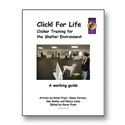Why does Clicker Training work in the shelter?
- Clicker Training uses a clear, distinct signal that is unemotional and consistent. Animals learn quickly from an occasional click and treat, here and there, for desirable behavior such as sitting instead of jumping on the kennel door, or being quiet instead of barking. The more information an animal receives about its environment, the more calmness and confidence that animal will display. The calmer and more confident the animal appears, the sooner it will be adopted.
Why is Clicker Training better than positive attention and food or other methods?
- Because the click sound pinpoints the behavior exactly, with clicker training, animals can learn desirable behavior quickly-- often from one or two clicks-and the information is retained forever. This is important in the shelter environment, because there is seldom any time to train in the traditional manner through correction and repetition. Clicker training is flexible, so it can be woven into the daily shelter activities such as feeding animals and cleaning cages. Clicker training's all-positive methodology and ease of use makes volunteers and shelter staff enthusiastic participants.
What results should my shelter expect and when?
- Shelters that have integrated clicker training into their animal care and shelter management have seen significant improvements in adoption rates, lowered euthanasia rates, and greater numbers of sustained adoptions. They also experience a calmer and more sociable atmosphere in the kennels and a greater enthusiasm and lower turnover among shelter staff. A shelter can experience positive results from focused programs such as "Creating a No Bark Zone" in just a few days! The dramatic improvements seen by shelters to date have been experienced in as little as the initial 6-12 months.
Is training experience required to be an effective volunteer?
- Shelters have been "converted" to clicker training by volunteers with belief and enthusiasm and hardly any formal training experience. These volunteers committed themselves to learning clicker training and applying themselves to specific behavior modification goals (like "Creating a No Bark Zone"). Success bred interest and more success among co-shelter workers.
I have dogs in my shelter that don't respond to anything! What can I do?
- Have the group name the dogs that don't participate, and pick someone to watch and write down what each dog does when someone tries to clicker train it.
- Now arrange things so the unresponsive dogs get to watch other dogs being clicker trained, without having to participate themselves (put them in crates, or train near their kennels, or use tethers.) Then give each one just a brief chance to earn clicks and treats for eye contact or for targeting, while still in the crate, kennel, or on the tether, at the end of the training session for the other dogs. Keep these sessions short. Put the observer dogs back in the kennel right away to think it over (do any necessary walking and pottying before this Observer session.)
- After two or three sessions like this, have someone watch and write down what each dog does NOW when someone tries to clicker train it. Send me the results!
Some of my volunteers are having difficulty coordinating the leash, clicker and treats. Any suggestions?
- Sure. Try the following easy solutions.
- Keep treats in a bowl on a shelf. Keep just a few treats in your hand and get more as you need them. Or keep treats in a treat bag on your waist. Cheap canvas carpenter's aprons can be obtained at hardware stores for treat bags or try treat bags which are sturdier, stylish and more functional with places to store treats and your clicker
- Put the clicker on a holder so that it is covenient when you need it, but out of the way when you don't. Popular styles are the lanyard style, retractable hip style or clip on / coil style. All work well.
- Get the leash out of your hands, at least during early stages of training:
- Train 'through the bars' with the dog still in the kennel.
- Tie the leash around your waist.
- Train in a small space (like a hallway) and teach "Walk with me" without a leash. c/t the dog for being next to you for one step, two steps, turns, speed up, etc. This transfers to pretty easily to doing the same thing on leash in more distracting areas.
- Tether the dog to a fence or a post (some shelter training rooms have ringbolts in the walls so dogs can be tethered out of reach of each other.) Work on down, sit, high five and other behaviors with you standing free and the dog tied. The more different things the dog learns while tethered the easier time you will have of it later when he is out walking with you and in distracting circumstances.
- Try the Hands Free Leash. It frees your hands. And you can easily attach multiple dogs
How do I fit training into an already busy schedule?
- Remember that a single click and treat can teach the dog something. Practice 'drive by' training by clicking and treating dogs for eye contact, happy tails, four on the floor or other desired behaviors, when you are passing through the kennels. Put kibble and clickers outside each cage so anyone can reinforce good behavior.
- Plan short sessions-two or three minutes-at the end of walks (not the beginning).
- Have a weekly meeting about training; set goals, even if it's just five minutes per day per person, small increments of training times add up fast. Keep track of training; keep clipboards outside kennels with a standard list of behaviors; anyone can check off a behavior when it's been accomplished. Reinforce everyone who worked on a particular dog when that dog finds a home.
For assistance designing a clicker program for your shelter, contact a Karen Pryor Academy Certified Training Partner
| Attachment | Size |
|---|---|
| click_for_no_bark_zone.pdf | 85.79 KB |
| clicker_for_shelters_brochure.pdf | 295.6 KB |
| clicker_for_veterinarians_brochure.pdf | 295.76 KB |
| one_page_summary_of_clicker_training.pdf | 155.09 KB |
| using_the_clicker_in_the_shelter_environment.pdf | 17.39 KB |






